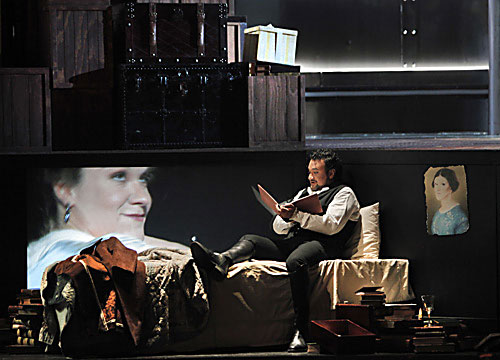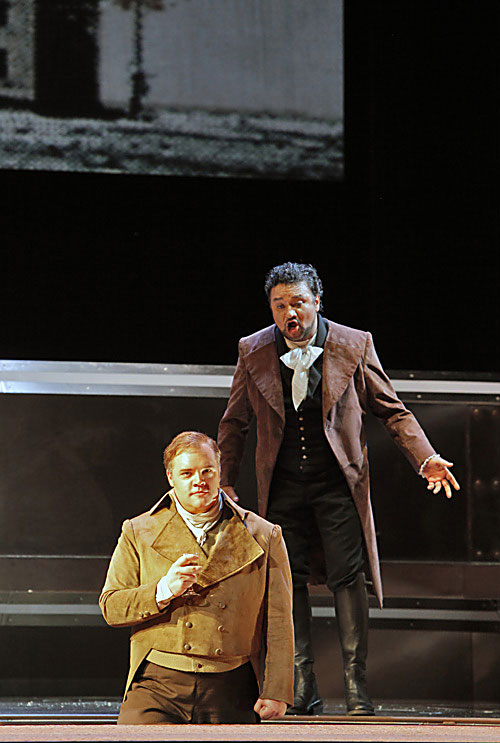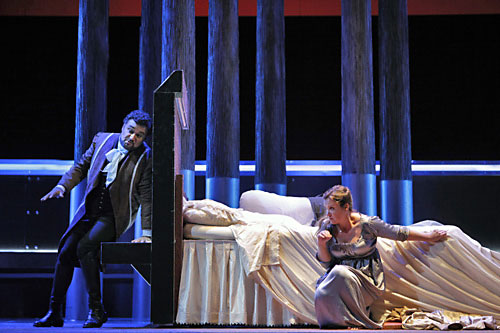|
Just one look at the stage set and I knew: doomed, doomed, doomed! This new Werther, after 25 years of absence from San Francisco Opera's repertoire, would dig itself back into its grave in no time. The house and garden that in Goethe's The Sorrows of Young Werther embody all the dreamy charm a young poet-outsider could project upon the bourgeoisie, is a black box stage; a naked, raised timber platform with a few abstracted, naked trees, their trunks wrapped in metal. Metal-framed photographs of leaves descend for spring, then fall. A square hole hides a staircase going down. Instead of a mood of mourning for the loss of Charlotte's mother, a mountainous clutter of old furniture and boxes on the left invites a "garage sale." Most tellingly, the yard is confined by a metal barrier like a Metro passage-way. A neon strip on top glows up white and at times red. Aha: LIFE! Aha: BLOOD! DEATH! A concept production!
Upon entering this dead zone, the young poet Werther has to sing his ecstatic opening aria, looking around, telling himself, "This is paradise…" One goes, "Excuse me? Is this young man on a hallucinogenic trip or something?" Renowned Tenor Ramòn Vargas, under these conditions, is unable to make sense of Werther's ecstasy.
 |
Poor Werther has to live not as a winged poet in airy realms, but as a mole, in a cubby-hole below the stage, replete with books and unmade bed and Charlotte's pictures everywhere. In order to remind us that he is really really in love with Charlotte, Werther paints her name in bloody letters on the black cellar wall. A TV screen over his bed shows a rather unflattering video of Charlotte's head, turning apparently in the all-important waltz of enchantment that never happens onstage. The director, Francisco Negrin (from Mexico), didn't think it was important to show the mutual fascination between Werther and Charlotte, which is based on the extended waltz Massenet wrote for them – a fairy-like music of deep, sensuous yearning and passion that is the heart of Act I. He relegated the waltz to background music for fussy stage activities involving Charlotte's entire family plus Albert, her betrothed.
The concept production's tell-all metal fence (production design by Louis Désiré) holds its promise: there is basically no rapport between the principals of this most romantic of operas. The director does not want us to feel emotions, that would really be too much, given the highly emotional music by Massenet. He wants us to be analytical, or what he believes is "psychological." To this effect, he interferes with the story, changes it ad libitum, tells the opposite of what the libretto tells, and even cuts text that is being sung from the supertitles when it contradicts his psychology: "Albert is not here," Charlotte's young sister Sophie comments in Act III, but you wouldn't know unless you know French, because Albert is right there, spoiling everything.
A whole-hearted mess ensues. Nobody is likable in this production although everyone sings very well. The husband (American baritone Brian Mulligan as Albert) is presented as a boor – perhaps to explain (psychologically) that Charlotte only married him out of duty, as she had promised her dying mother. If he is a boor, there is no tension in the story. If there is no romance, there is no drama in the making, therefore who cares?
The first 2 acts pass like chewing-gum pulled through one's teeth. French Conductor Emmanuel Villaume seems to have his own problems with the staging. He conducts the purely orchestral parts, the ouverture and interludes between the acts, with great passion, then goes into a crawl. Every now and then you prick up your ears: Massenet! Incredible music! Then you sink back again. The ugly houses projected in back (from someplace in New Jersey) seem to spell out American Puritanism, instead of the seductive combination of German-French Romanticism. Soprano Alice Coote's Charlotte is stiff-backed and "good" to her siblings like a school teacher. The audience has to suffer that the absent romantic drama is heaped upon Charlotte's young sister Sophie (beautiful, pearly-voiced Heidi Stober) who is portrayed as obsessed with Werther, stalking him, often in tears, no matter that her music and almost all her lines speak nothing but innocent joy – embodying precisely the child-like, happy spirit Werther sees in Charlotte's family home and longs for, in vain, from his cubby-hole under the stage.
 |
Apart from the ridiculous effect of people singing on the hidden stairs without bottoms and legs, like card-board apparitions, the little intimacy Charlotte has with Albert after their marriage is interfered with by the director by making their heart-to-heart part of an embarrassing public picnic. However, when Charlotte has her crisis of conscience over Werther's letters, beginning to admit to herself that she has undeniable, very troubling feelings for him, Negrin robs her of this soul-searching moment alone and instead, lets her absurdly read Werther's letters aloud to Albert ("Albert is not here…"), confessing how torn she is. What does Albert do? Psychology 101: He tears the letter up.
Act III has Negrin's big moment of "Now look at me!" A segment of the metal fence drives out toward stage-center, dragging Charlotte's marriage bed with an extended train of sheets behind it. Charlotte's realization of despair over loving Werther now happens on the bed in a dream state, and her anguished confrontation with Werther has Ramón Vargas cower behind that fenced-off bedroom wall while Charlotte dreams away like one of Freud's infamous cases of hysteria. Alice Coote now brings out what was hidden behind her puritanical mask, singing with vulnerable, plaintive intensity and great beauty. The duet is gripping if you close your eyes. If you open them, the combat between the misbegotten mise en scène and the rest of the opera continues.
 |
Suddenly surrealism takes over. During the powerfully Wagnerian interlude between Act III and IV three men in coats like Werther's run onto the darkened stage with burning torches. One of these Werthers, Ramòn Vargos, as it turns out, has a long sexual wrestling match with Charlotte which stops short of "let's do it on the stage." It stops when all three men line up, shoot themselves and fall together. It's certainly a wild ride, refreshing after the chewing gum acts, but it doesn't lead to any enlightenment or meaning. The scene ends back in questionable territory when Charlotte weepily hugs and hugs one of the corpses, while Ramón Vargas stands to sing the last duets upright, as a ghost.
Anyone truly interested in the potential of this opera (it premiered in Vienna in 1892), can simply turn to Netflix: Werther conducted by Libor Pesek, sung by the phenomenal Brigitte Fassbaender and equally matched Peter Dvorsky. You can't buy this opera-film by Peter Weigl from 1986 any longer; it is out of stock. Netflix is your lucky chance to experience Werther the way Massenet deserves it.
Peter Weigl's Werther is set at locations that are a fairytale of old Europe. Like in his brilliant film versions of Britten's Turn of the Screw or Tchaikovsky's Eugene Onegin, his eye for beauty and glorious landscapes or interieurs is as infallible as his sense of music and psychology. From the first image, you are in the enchanted nature Goethe evoked in his epistolary novel, which Massenet recreated in his music. Weigl, too, takes liberties with the libretto, intelligent ones, however, that place a laser-like focus on the tragic love story. He uses the ouverture to let Werther wander through summer meadows like in a Kaspar David Friedrich idyll; a gaggle of children and young women run through the meadows in billowing white skirts and petticoats: Charlotte and her young siblings. (You may recognize the excited laughter of the child heroine of The Turn of the Screw.) Werther observes in secret how Charlotte places flowers at her mother's grave, and already his fascination is believably established. He approaches a manor house (the banal first scene of the opera is cut), surrounded by majestic trees, and now his aria about "This is paradise…" is precisely what one sees and feels about the whole first act, bathed in summer light. The waltz music now flows through scenes of enchantment, moments at the ball, Werther and Charlotte drifting through the park at dawn, he mesmerized, she clearly smitten and hesitating to separate, until with a bang, a coach holds in front of the house. Charlotte, in shock, admits she "forgot for a moment" that she has a fiance, that she promised her dying mother to marry Albert. The cold that settles over her as she leaves Werther to follow her duty holds the essence of the drama: one can't believe her choice any more than Werther can; one intensely hopes she will change her mind, and the musical drama nourishes the tension of hope and heart-ache, dreams and despair.
Fassbaender's Charlotte has enough darkness and mystery in addition to her "goodness" to make her Werther's true soulmate, and handsome Dvorsky has the passionate fire you expect in a poet who is ready to give his life for her. But the third party in Goethe's interesting triangle, Albert, here is a sensitive, noble-minded and, moreover, good-looking fellow who also draws one's sympathies. So there is not just romantic folly, there is an interesting story and suspense. The climax is beautifully constructed. Werther, banned by Charlotte, returns at Christmas and expresses his despair, "Pourquoi me réveiller au souffle du printemps?" – the famous aria "Why should I awaken again to the breath of spring?" Charlotte can't hold back any longer. The poet's sad and fiery words are finally breaking down her resolve never to admit her love for the man. The gripping music that carries this moment makes the scene as convincing as the rest of the opera. Under Czech conductor Libor Pesek, Massenet's music is pronounced lyricism, scintillating sound-color with echos of Poulenc's passionate "Nuits d'été" and even Tchaikovsky (the dream-like waltz resembles the ancient French song in the last act of The Queen of Spades) – creating a strangely addictive effect of ecstasy. Under Emmanuel Villaume in San Francisco, Massenet has his Wagnerian reminiscences and growing dramatic urgency toward the end, but otherwise is flat, robbed of all lyrical magic, to the point of being almost unrecognizable.
The question of artistic operatic politics arises once again. General directors like San Francisco Opera's David Gockley will hardly attract audiences by allowing their hired production directors to sabotage and annihilate what is the very essence of grand opera: big musical drama, big romance, tragedy, huge feelings expressed in music, acting and scenery. One can't say it often enough: Opera is the only romantic art form left to our distracted, cold, analytical, post-post-modern world. The main audience for opera is on average 65 years old. The idea that younger audiences would have any interest in seeing and hearing their modern world mirrored in botched grand opera is a bizarre miscalculation. On the contrary: soon enough we will probably see the dawn of a new romantic era, a renaissance of feeling, of high emotion – a badly needed break from the cultural starvation of our time. Opera could be a leading force in this new direction. But why would anyone want to go to the opera to hear opera directors sawing away at the one branch they have left to sit on?
Photos - Cory Weaver
Nice excerpt from the 1986 Peter Weigl film:
|
|

